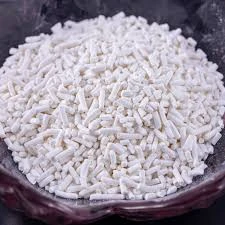
Exploring the Benefits and Uses of E965 Sweetener in Modern Food Products
Understanding E965 Sweetener A Comprehensive Guide
In recent years, the awareness and demand for healthier sweetening alternatives have surged, leading to an array of sugar substitutes entering the food market. Among these, E965, commonly known as maltitol, has gained significant popularity. This article aims to delve into the nature of E965, its benefits, potential drawbacks, and its role within our diets.
What is E965?
E965 is a food additive classified under sugar alcohols, specifically maltitol, and is commonly used as a sugar substitute in many food products. It’s derived from maltose, which is a sugar produced from starch, usually corn, wheat, or tapioca. The resulting sweetener is about 75-90% as sweet as sucrose (table sugar), making it an attractive alternative for those seeking to reduce their sugar intake without sacrificing sweetness.
Benefits of E965
One of the primary advantages of E965 is its lower caloric content compared to regular sugar. Maltitol contains roughly 2-3 calories per gram, depending on the specific formulation, compared to about 4 calories per gram for standard sugar. This lower caloric density makes E965 particularly appealing to individuals pursuing weight management or those with diabetes who need to monitor their carbohydrate intake.
Additionally, E965 has a low glycemic index (GI) rating, typically around 35. This means it has a minimal impact on blood sugar levels, making it a safer choice for people with insulin sensitivity or diabetes. Moreover, it does not contribute to tooth decay, as it is not fermentable by the bacteria found in the mouth that cause cavities.
Applications in Food Products
E965 is widely used in various food items, including sugar-free candies, chocolates, baked goods, and dairy products. Its ability to retain moisture makes it an excellent choice for enhancing the texture and shelf life of these products. Maltitol also provides sweetness without the bitter aftertaste associated with some artificial sweeteners, making it a preferred option for food manufacturers.
e965 sweetener

Potential Drawbacks
While E965 has numerous benefits, it is essential to be aware of its potential drawbacks. The consumption of sugar alcohols like maltitol can lead to gastrointestinal discomfort for some individuals. Symptoms may include bloating, gas, and diarrhea, especially when consumed in large quantities. This side effect arises because sugar alcohols are not fully absorbed by the body and can ferment in the intestines.
As with any sweetener, moderation is key. It’s important to be mindful of personal tolerance levels and consult with healthcare professionals, particularly for diabetic individuals or those with gastrointestinal disorders.
Regulatory Status and Safety
E965 has been evaluated by several food safety authorities, including the European Food Safety Authority (EFSA) and the U.S. Food and Drug Administration (FDA), both of which consider maltitol safe for consumption within established daily intake limits. The acceptable daily intake (ADI) is set at 0-60 mg/kg of body weight, allowing for ample flexibility in its use in food products.
Conclusion
E965, or maltitol, presents a valuable alternative for those looking to minimize their sugar intake while still enjoying sweet flavors in their diets. Its benefits, such as lower calories, reduced impact on blood sugar levels, and lack of dental concerns, make it an attractive option for various consumers. However, potential gastrointestinal issues and the necessity to consume it in moderation are important considerations.
As the market continues to evolve, and consumers become increasingly health-conscious, E965 may play an integral role in the formulation of sugar-free and low-calorie products. By understanding the properties and effects of E965, individuals can make informed choices about their sweetening options, contributing to a balanced and health-oriented lifestyle.
-
Aluminum Hydroxide: Quality Gels & Dried Gel AntacidNewsAug.31,2025
-
Buy High-Quality Trichloroisocyanuric Acid for Sale | TCCA 90% SupplierNewsAug.30,2025
-
Pure Sodium Dichloroisocyanurate Dihydrate | Powerful DisinfectantNewsAug.29,2025
-
Industrial Chemicals: Quality & Purity for Every IndustryNewsAug.28,2025
-
Nitrile Rubber Honoring Strict Production StandardsNewsAug.22,2025
-
Aspartame Ingredients Honoring Food Safety ValuesNewsAug.22,2025
-
Fertilizer for Balanced Plant NutritionNewsAug.22,2025
Hebei Tenger Chemical Technology Co., Ltd. focuses on the chemical industry and is committed to the export service of chemical raw materials.
-

view more DiethanolisopropanolamineIn the ever-growing field of chemical solutions, diethanolisopropanolamine (DEIPA) stands out as a versatile and important compound. Due to its unique chemical structure and properties, DEIPA is of interest to various industries including construction, personal care, and agriculture. -

view more TriisopropanolamineTriisopropanolamine (TIPA) alkanol amine substance, is a kind of alcohol amine compound with amino and alcohol hydroxyl, and because of its molecules contains both amino and hydroxyl. -

view more Tetramethyl Thiuram DisulfideTetramethyl thiuram disulfide, also known as TMTD, is a white to light-yellow powder with a distinct sulfur-like odor. It is soluble in organic solvents such as benzene, acetone, and ethyl acetate, making it highly versatile for use in different formulations. TMTD is known for its excellent vulcanization acceleration properties, which makes it a key ingredient in the production of rubber products. Additionally, it acts as an effective fungicide and bactericide, making it valuable in agricultural applications. Its high purity and stability ensure consistent performance, making it a preferred choice for manufacturers across various industries.





